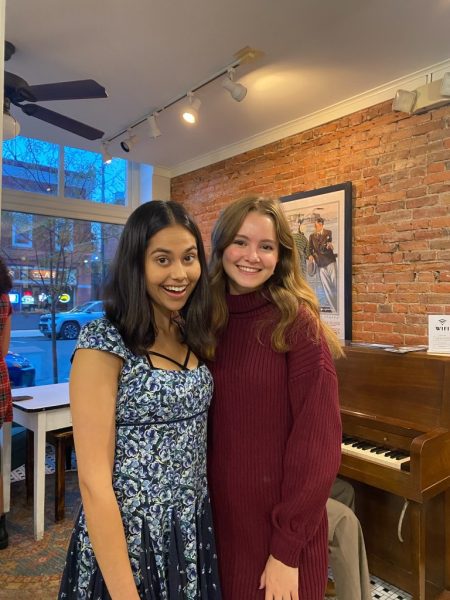The Green Afternoon of Service: COVE’s Community Garden Event
Every year, the Center for Outreach, Volunteerism, and Education (COVE) honors national days of service by hosting events in which students spend an afternoon volunteering with a local community organization. Having already held events for 9/11 and MLK day, the COVE hosted its most recent “Afternoon of Service” at the Colgate Community Garden in order to celebrate Earth Day. Located a little south of the townhouse area, the Community Garden gives students a chance to gain hands-on experience in organic gardening and connect with others who share the same interest.
The Community Garden was started by Megan Cornin ‘10, Teddi Hofmann ‘10, Maria Kryachko ‘10, and Kate Pavelick ‘10 in 2009 as a research project for their senior seminar in environmental studies. After receiving funding from the class gift of the class of 2010 and joining forces with the Green Thumbs — a student organization dedicated to the Garden itself — the project was able to expand into a full-fledged garden during the summer of 2010 as it moved into a plot of land across from Newell Apartments. In 2014, the garden was moved to an area more suitable for growing, behind Good Nature Brewery. This past summer, the garden was relocated again to an area just south of the townhouse community.
While working for the Office of Sustainability this summer, Sophie Schadler, a junior concentrating in environmental geography and minoring in economics, helped in the most recent efforts to relocate the garden. Working with three other interns and the garden’s manager Beth Roy, Schadler helped brainstorm new ideas for the garden’s layout and up-keeping its produce.
“Each of us interns had our own raised bed where we tended to a variety of plants throughout the summer…We put together raised beds…We also planted, weeded, watered, and harvested, hauled wheelbarrows of dirt, and organized the garage shed,” Schadler recalls.
The Community Garden was not only founded by students but it also continues to be managed by students. In addition to the Green Thumbs’ leadership, other student groups, such as the Beekeeping Club and interns for the Office of Sustainability, assist in the field’s management and upkeep. Through volunteer hours, volunteer groups, student research projects and campus events, the garden offers a multitude of opportunities for the involvement of all students.
This past Afternoon of Service embodied the spirit of the garden’s mission as an opportunity for students to come together, learn about organic gardening and actually work and contribute to the garden itself. This event was part of Colgate’s annual “13 Days of Green,” a nearly two-week period dedicated to highlighting Colgate’s sustainability initiatives in honor of Earth Day. According to Helen Lin, one of the leaders of this event and a junior conentrating in geography and studio art, the event provided students with a chance to take a break from their studying as they learned about the basics of gardening, the importance of plant maintenance, and the multitude of plants available in the garden.
“The Afternoon of Service is part of the 13 Days of Green activities. Students could volunteer at the community garden near townhouses. It gives students opportunities to work in the field, take a study break, and also enjoy the nice weather outside. Working at the garden also allows them to know more about the garden and local food providers,” Lin recalled.
The garden is home to many types of produce, growing anything from fruits and vegetables to herbs and flowers. In addition to growing produce, the nursery also has several apiaries that contain as many as four honey bee hives. Managed by the Beekeeping Club, these hives not only generate honey for harvest but also aid with plant growth. According to Roy, the garden’s variety of products provide an opportunity for both its volunteers and visitors to really learn about organic gardening.
“The Colgate Community Garden grows anywhere from 30-40 different types of products every year! We grow fruits, vegetables, herbs, and flowers. We also have several apiaries located in the garden that produce honey. We grow such a large variety of products so that we can educate our visitors about how to grow different things,” Roy said.
With eleven different plots of land, the Garden is able to grow a large amount of produce that can be given to both Colgate and the wider Hamilton community. Half of all of the garden’s produce is donated to people in need through the Hamilton Food Cupboard while the other half is sold to campus organizations, such as Dining Services and the Chapel House, and can be purchased at the Farm Stand on campus.
“We are able to produce over 3,000 pounds of food each year. Half of this food is donated to people in need via the Hamilton Food Cupboard. The other half is sold to Dining Services, the Chapel House, or sold at a weekly Farm Stand on campus,” Roy said.
The garden’s close relationships with the Colgate and wider-Hamilton communities relate to part of its mission, which is to educate students and residents about local, small-scale organic farming and gardening. In addition to its contributions to the Hamilton Food Pantry and Dining Services, the garden has also recently started a composting program with several Greek Life Organizations as of this spring. The Garden hopes to become even more involved with the Colgate community in particular and become a common gathering place for classes, students, and Hamilton residents.
“Colgate University is interested in bringing the garden more into the fold of the school to make it a destination for students and classes, as well as local community members and volunteers,” Roy said.















Sally Lehmann • May 5, 2022 at 9:12 pm
It’s great that Colgate offers this kind of education. And that they encourage students to love this wonderful world of nature.
It’s also a great article!